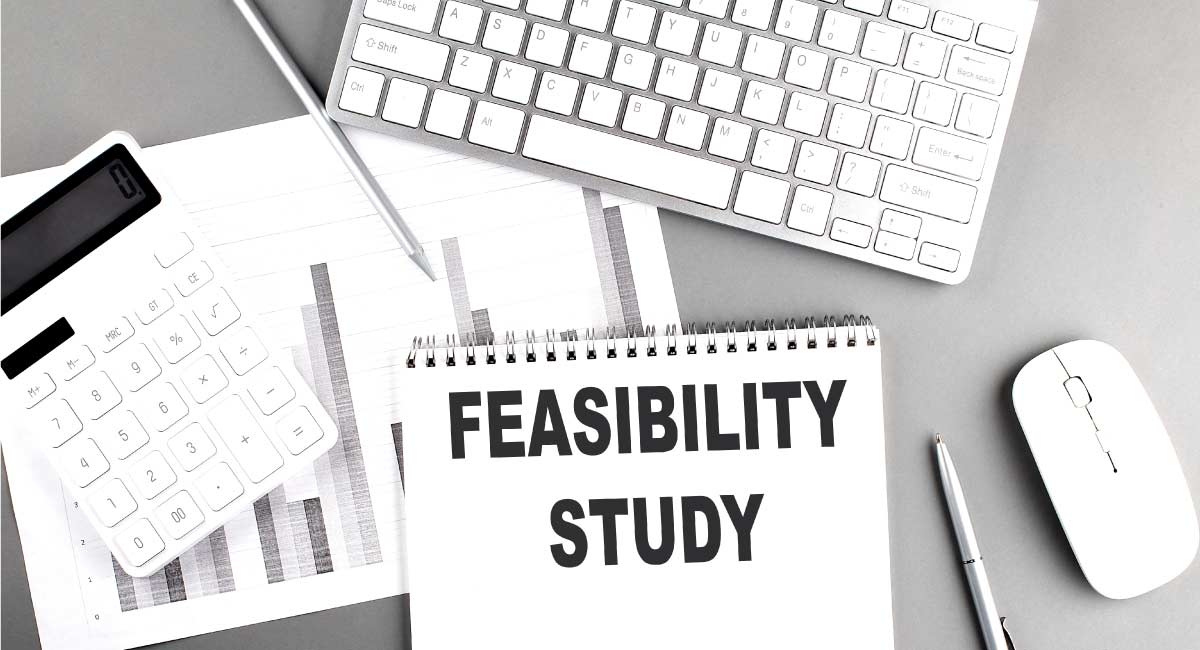Projects fail; that’s just a fact of life for many project managers. However, many failures can be avoided with proper planning and assessment, starting with a comprehensive feasibility study. This step examines factors like market viability, objectives, obstacles, and resource requirements, giving project leaders and stakeholders a clear picture of whether their proposed project is viable and worth pursuing.
In this article, we delve into the importance of feasibility studies in project management and offer practical insights into their application. We will also recommend an industry-recognized project management program that will help you acquire the skills essential to succeed in a career as a project manager.
What is a Feasibility Study?
A feasibility study thoroughly assesses whether a proposed project can succeed. Business success hinges on ROI, which reflects the project’s profitability. This study examines a project’s practicality by analyzing its strengths, weaknesses, opportunities, threats, required resources, and chances for success. Two main factors considered are the project’s costs and expected returns.
Feasibility studies determine if a project is viable and likely to succeed. They evaluate legal, technical, and economic feasibility to ensure the project merits investment. Sometimes, projects are deemed unfeasible due to high resource requirements that outweigh potential earnings.
A well-designed feasibility study should cover the project’s background, product or service description, financial statements, operations and management details, marketing research, economic forecasts, legal considerations, and tax obligations. Typically, these studies precede technical development and project implementation.
Also Read: What is a Project Management Office? A Beginner’s Guide
Feasibility Study Examples
A local university was concerned about its science building, which was built in the 1970s. School officials wanted to assess the costs and benefits of expanding and upgrading the facility, given advancements in science and technology over the past 20 years. To do this, they conducted a feasibility study.
Officials explored various options, considering the costs and benefits of updating and expanding the science building. They were concerned about project costs and public opinion, especially since the proposed new building would be larger than the current one. Similar proposals had previously faced community board rejection, raising legal and zoning issues addressed in the feasibility study.
The study examined technology requirements for the new building, potential student benefits, and long-term sustainability. Modernizing the facility would enhance scientific research capabilities and improve academic programs, potentially attracting new students.
Financial projections detailed the project’s scale, costs, and fundraising strategies, such as issuing bonds and using endowment funds. These projections highlighted how the upgraded science program could increase student enrollment, boosting tuition and fee revenue.
The feasibility study confirmed that expanding and modernizing the building was feasible. Without it, school administrators would not have known the viability of their expansion plans.
What is a Feasibility Study, and Why is it Critical for Project Managers?
Here are some key benefits of conducting a feasibility study:
Identifies New Opportunities
Conducting a feasibility study uncovers potential market gaps, technological advancements, or operational efficiencies that the project could capitalize on, offering fresh perspectives and innovative ideas.
Provides Critical Information for a “Go/No-Go” Decision
It furnishes decision-makers with comprehensive insights into project feasibility, including cost-benefit analyses and risk assessments, which are crucial for determining whether to proceed with the project.
Narrows Business Alternatives
By evaluating various project options and their potential outcomes, a feasibility study aids in streamlining decision-making processes, enabling organizations to focus on the most viable and profitable opportunities.
Identifies a Strong Reason to Undertake the Project
A feasibility study validates the project’s rationale by thoroughly analyzing market demand, financial viability, and strategic alignment, ensuring it aligns with organizational goals and objectives.
Enhances Success Rate by Evaluating Multiple Factors
A feasibility study examines market dynamics, technical feasibility, and resource availability to enhance project planning and implementation strategies and improve the likelihood of achieving project goals.
Aids Decision-Making on the Project
Armed with comprehensive data and analysis from the feasibility study, project stakeholders can make informed decisions at every stage of the project lifecycle, from inception to execution, ensuring alignment with overall business objectives.
Identifies Reasons not to Proceed
By identifying potential risks, feasibility studies highlight obstacles and challenges hindering project success, allowing organizations to mitigate these issues or reconsider the project altogether.
In addition to these approaches, some projects require other constraints to be analyzed:
- Internal Project Constraints: These include technical, technological, budgetary, and resource constraints.
- Internal Corporate Constraints: Including financial, marketing, and export considerations.
- External Constraints: Logistics, environmental factors, and laws and regulations.
Also Read: AI for Project Management: Creating More Efficiency, Accuracy, and Better Results
Purpose of a Feasibility Study
A feasibility study is a crucial initial step in launching a new business. It involves thoroughly examining the likelihood of success for a proposed business venture. The study aims to provide essential information that guides business owners in making well-informed decisions about their new endeavors.
Key questions addressed by the feasibility study include:
- Who is the target market for this business?
- Who are the main competitors?
- What are the startup and operational costs involved?
- What are the possible risks and benefits linked to this venture?
- How much income can the business generate?
- What are the projected profits and potential losses?
- What growth opportunities exist within this industry?
What is a Feasibility Study? Examining Types
Five distinct types of feasibility studies examine different aspects, outlined below:
Technical Feasibility
This evaluation focuses on the organization’s technical resources. It determines if existing technology can support the project and assesses the technical team’s capability to implement the proposed system. For example, implementing technology like Star Trek’s transporters would not be technically feasible.
Economic Feasibility
This assessment involves a cost-benefit analysis to gauge the project’s financial viability. It helps organizations understand the costs and economic benefits the project can deliver, thereby bolstering project credibility.
Legal Feasibility
This assessment checks if the project complies with legal requirements such as zoning laws or data protection regulations. For instance, a feasibility study might reveal that a proposed office building location doesn’t meet zoning requirements, saving the organization time and effort.
Operational Feasibility
This study analyzes whether the project can effectively meet the organization’s operational needs and ensures that the plan aligns with the requirements identified during the system development phase.
Scheduling Feasibility
This assessment determines the project’s timeline and ensures that it can be completed within the expected timeframe, which is critical for project success.
Once these areas are thoroughly examined, the feasibility analysis identifies potential constraints the project may encounter, including:
- Internal Project Constraints: Technical capabilities, technology requirements, budget constraints, and resource availability.
- Internal Corporate Constraints: Financial considerations, marketing strategies, and export regulations.
- External Constraints: Logistical challenges, environmental factors, and legal regulations.
Benefits of a Feasibility Study
Preparing a feasibility study for a project is a crucial step that helps project managers make informed decisions about investing time and money in the endeavor. Feasibility studies also enable company management to avoid risky business ventures by providing critical insights.
Another benefit of a feasibility study is its role in launching new ventures. It provides essential information on how a business will operate, potential challenges it may face, competitors in the market, and sources and amounts of funding. Feasibility studies aim to convince investors and banks whether investing in a specific business venture is worthwhile.
Also Read: Exploring Top AI Project Management Tools
What Is Included in a Feasibility Study Report?
When preparing a feasibility report, several factors are considered, including marketability, competition, financial stability, technology requirements, and ROI.
The findings of a feasibility study are summarized in a feasibility report, typically including these sections:
- Executive Summary: A concise overview summarizing the feasibility study’s key findings, conclusions, and recommendations.
- Specifications of the Item or Service: Detailed description outlining the proposed product or service’s features, functions, and attributes.
- Considerations for Future Technology: Exploration of technological trends and advancements that may impact the project’s implementation and sustainability.
- Marketplace for Goods and Services: Analysis of the target market, including size, demographics, trends, and competitive landscape.
- Approach to Marketing: Strategic plan detailing how the product or service will be promoted, priced, distributed, and positioned in the market.
- Organization/Staffing: Structure and staffing requirements, including roles, responsibilities, and organizational hierarchy necessary for project execution.
- Schedule: Timeline outlining key milestones, tasks, and phases required to complete the project within specified timeframes.
- Financial Forecasts: Projections of costs, revenues, cash flows, and economic performance expected throughout the project lifecycle.
- Recommendations Based on Research: The feasibility study findings provide conclusions and actionable recommendations that guide decision-making and future steps.
What is a Feasibility Study, and How Do You Conduct One?
When preparing a feasibility study, consider these key aspects:
- Define your target market and outline your strategy to reach them.
- Provide a detailed description of your product or service, emphasizing its uniqueness and necessity.
- Present your financial projections and explain your strategy for achieving profitability.
Tools for Conducting a Feasibility Study
While each project varies in goals and requirements, the following best practices are crucial for conducting a feasibility study:
- Conduct a preliminary analysis, gather relevant stakeholders’ input and explore alternative business scenarios.
- Ensure data integrity by asking critical questions during the initial phases.
- Conduct a market survey to assess demand and identify opportunities for the new concept or business.
- Develop an organizational, operational, or business plan detailing required resources, costs, and timelines.
- Prepare a projected income statement outlining revenue, operating expenses, and anticipated profits.
- Establish an opening day balance sheet to assess initial financial standing.
- Identify and address potential vulnerabilities or obstacles.
- Make an informed decision on proceeding with the plan.
Start Your Journey to Becoming a Skilled Project Manager
A feasibility study is essential for evaluating project viability. It guides informed decision-making and enhances project success rates by identifying potential challenges and opportunities. As an aspiring project manager, mastering feasibility studies is crucial for overseeing complex projects.
Get started by enrolling in a comprehensive project management bootcamp. This program helps you accelerate your project leadership journey. It’s a three-month online bootcamp featuring interactive classes, Harvard Business case studies, gen AI modules, and a practical capstone project. Ideal for aspiring project managers aiming to excel in complex projects.
You might also like to read:
How to Negotiate the Best Project Manager Salary
What is Enterprise Resource Planning, And How Does It Help Organizations?
What Are Network Diagrams in Project Management, and Why Are They Effective?
What is the Pomodoro Technique & How Does It Help in Time Management?







